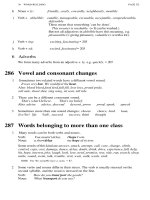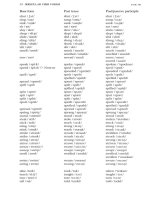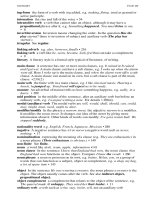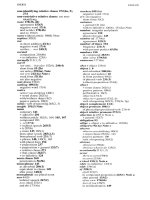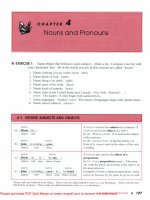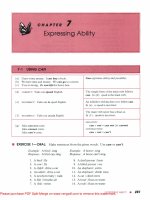English grammar for beginners doc
Bạn đang xem bản rút gọn của tài liệu. Xem và tải ngay bản đầy đủ của tài liệu tại đây (3.98 MB, 145 trang )
Just Enough
ENGLISH
GRAMMAR
Illustrated
Gabriele Stobbe
New York Chicago San Francisco Lisbon London Madrid Mexico City
Milan New Delhi San Juan Seoul Singapore Sydney Toronto
Copyright © 2008 by Gabriele Stobbe. All rights reserved. Manufactured in the United States
of America. Except as permitted under the United States Copyright Act of 1976, no part of this
publication may be reproduced or distributed in any form or by any means, or stored in a
database or retrieval system, without the prior written permission of the publisher.
0-07-159497-3
The material in this eBook also appears in the print version of this title: 0-07-149232-1
All trademarks are trademarks of their respective owners. Rather than put a trademark symbol
after every occurrence of a trademarked name, we use names in an editorial fashion only, and
to the benefit of the trademark owner, with no intention of infringement of the trademark.
Where such designations appear in this book, they have been printed with initial caps.
McGraw-Hill eBooks are available at special quantity discounts to use as premiums and sales
promotions, or for use in corporate training programs. For more information, please contact
George Hoare, Special Sales, at or (212) 904-4069.
TERMS OF USE
This is a copyrighted work and The McGraw-Hill Companies, Inc. (“McGraw-Hill”) and its
licensors reserve all rights in and to the work. Use of this work is subject to these terms. Except
as permitted under the Copyright Act of 1976 and the right to store and retrieve one copy of
the work, you may not decompile, disassemble, reverse engineer, reproduce, modify, create
derivative works based upon, transmit, distribute, disseminate, sell, publish or sublicense the
work or any part of it without McGraw-Hill’s prior consent. You may use the work for your
own noncommercial and personal use; any other use of the work is strictly prohibited. Your
right to use the work may be terminated if you fail to comply with these terms.
THE WORK IS PROVIDED “AS IS.” McGRAW-HILL AND ITS LICENSORS MAKE NO
GUARANTEES OR WARRANTIES AS TO THE ACCURACY, ADEQUACY OR
COMPLETENESS OF OR RESULTS TO BE OBTAINED FROM USING THE WORK,
INCLUDING ANY INFORMATION THAT CAN BE ACCESSED THROUGH THE
WORK VIA HYPERLINK OR OTHERWISE, AND EXPRESSLY DISCLAIM ANY
WARRANTY, EXPRESS OR IMPLIED, INCLUDING BUT NOT LIMITED TO IMPLIED
WARRANTIES OF MERCHANTABILITY OR FITNESS FOR A PARTICULAR
PURPOSE. McGraw-Hill and its licensors do not warrant or guarantee that the functions
contained in the work will meet your requirements or that its operation will be uninterrupted
or error free. Neither McGraw-Hill nor its licensors shall be liable to you or anyone else for
any inaccuracy, error or omission, regardless of cause, in the work or for any damages
resulting therefrom. McGraw-Hill has no responsibility for the content of any information
accessed through the work. Under no circumstances shall McGraw-Hill and/or its licensors be
liable for any indirect, incidental, special, punitive, consequential or similar damages that
result from the use of or inability to use the work, even if any of them has been advised of the
possibility of such damages. This limitation of liability shall apply to any claim or cause what-
soever whether such claim or cause arises in contract, tort or otherwise.
DOI: 10.1036/0071492321
Introduction
v
Nouns
1
Adjectives
27
Pronouns
37
Verbs
61
Adverbs
97
Prepositions
107
Conjunctions
117
Interjections
123
Answer Key
129
CONTENTS
For more information about this title, click here
This page intentionally left blank
v
What This Book Contains
■
Just Enough English Grammar Illustrated requires no formal
exposure to English grammar. The book is designed to give
learners of English a basic grammar foundation. It may serve
other students as a reference or review tool.
■
This book takes a practical approach. It does not focus on rules
and definitions. Instead, it studies how words work and what
they do in sentences.
■
The material is presented in an easy, step-by-step format.
As the learner moves through the book, he or she will gain
an understanding of the basic principles of the English
language. These principles are laid out simply but thoroughly,
and each new principle builds on what the student learned
earlier in the book.
■
Real-life scenarios use interesting characters and engaging,
simple vocabulary. Basic English structures presented in
visually engaging graphics bring grammar alive and therefore
increase the student’s desire to learn grammar.
■
Carefully designed graphic illustrations translate grammatical
concepts into visual images. Each topic or grammar concept is
clearly explained with relevant graphic illustrations. They make
comprehension possible without wordy explanations.
■
Graphic organizers and Venn diagrams clarify concepts
and help the reader review. They stimulate creative and logical
thought processes, and also help the student to evaluate and
categorize language structures.
■
Review Exercises and the Answer Key provide the learner
with the opportunity to test his or her skills.
■
This book offers choices. It takes into account the different
ways in which students learn and, accordingly, provides a
variety of learning tools. From real-life scenarios to illustrations
and graphic organizers, there is something for everyone.
INTRODUCTION
Copyright © 2008 by Gabriele Stobbe. Click here for terms of use.
vi
Organization of Chapters
Your Framework
The eight chapters of this book are organized around the
eight parts of speech. It is important to become familiar with
the name of each part of speech and to expand your knowledge
about each one. The parts of speech will become the overall
framework of your English language knowledge. It is to this
framework that you will add important information necessary
to build your basic grammar foundation.
The following strategies were designed to show you how these
eight parts of speech can help you to build your foundation.
Your Strategies: Words are Tools for Communication
Strategy #1: How to Use Your Tools
Becoming familiar with your tools is the first strategy.
Words are tools for communication. The vocabulary words
used in this book were chosen because of their applicability
to real-life scenarios. Your tools—a set of illustrated vocabulary
words—are at the end of this Introduction. The players
represented throughout the book are everyday people. They
add spark and a new, refreshing approach to what is usually
dry material. The illustrations of all key players are followed by
brief biographies with interesting details about the lives of the
main personalities.
Adjectives
Prepositions Conjunctions Interjections
Pronouns Verbs Adverbs
Nouns
Who
or What?
Who
or What?
How the
Verb Acts
How the
Noun or
Pronoun Looks
What the
Noun or
Pronoun Does
How Prepositions
and Conjunctions
Connect the Words
vii
Strategy #2: Basic Language Concept Number One:
Form of the Eight Parts of Speech
Communication generally means putting words together
to express your thoughts in context. Before you can put words
together effectively, you must comprehend basic language
concepts. This book emphasizes an understanding of key
grammatical concepts over the memorization of individual
words.
Most of the chapters in this book are divided into two parts.
Typically, the part of speech that is the focus of the chapter
is first discussed in terms of its form—the qualities that it has
in common with other parts of speech. Then the use of each part
of speech is considered.
What Information Do All of These Parts of Speech Give?
In this book, you will learn about three important concepts:
number, gender, and grammar person. Part One of several of
the chapters will show how these three concepts are expressed
in the different parts of speech.
Strategy #3: Basic Language Concept Number Two:
Use of the Eight Parts of Speech
What Jobs Can All of These Parts of Speech Do?
Part Two will build on what you learn in Part One. In many
chapters, Part Two explains the jobs that different parts
of speech perform in a sentence, as well as the relationships
between different words within a sentence. A thorough
understanding of the concepts covered in Part One will make
Part Two seem much easier!
Adjectives
Prepositions Conjunctions Interjections
Pronouns Verbs Adverbs
Nouns
Adjectives
Prepositions Conjunctions Interjections
Pronouns Verbs Adverbs
Nouns
viii
Your Tools: English Vocabulary Words
bikini locker room towel life preserver
beach ball suntan lotion sunglasses pool
flippers umbrella bathing suit lifeguard chair
Mexican hat air mattress diving board whistle
pool ladder hamburger hot dog goggles
ix
Your Players: Family and Friends
Mr. Miller
father
Ben
the boy
Kelly
the young girl
Andy
the young boy
Charles Smith
the man
Mrs. Miller
the woman
the boys the girls
the teacher
Jake
the boy
Susan
the girl
Maria
the girl
Anna
the girl
Mrs. Miller
mother
Andy Miller
son
Anna Miller
daughter
Anna
sister
Andy
brother
the children
the pool manager
The Miller Family
Lakeside Pool Friends
the parents
x
MEET THE
PLAYERS
Susan
Susan lives in Miami, Florida. She is 16 years old.
Susan is the lifeguard at Lakewood Pool. She is
also on the swim team. Susan always wears her
lucky red swim cap to swim meets. She dates Ben.
Susan has a little brother named Tim. Tim likes
to cheer for Susan at swim meets. She also has
a cat named Snowball. Susan and her best friend,
Anna, enjoy shopping, and they often babysit for
their neighbor Kelly.
Ben
Ben moved to Miami three years ago. He is 17 years
old. Ben has an older sister named Claire. He also
has a puppy named Shadow. He is good friends with
Charles Smith, the pool manager. He joined the swim
team two years ago. Ben joined because he liked
Susan, but now he is a very serious swimmer. He is
always competing with Jake. Ben has trouble with
grammar at school. He wants to study grammar this
summer. Ben likes to surf and go bowling when he
is not at the pool.
xi
Anna
Anna moved to Miami six months ago. She is from
Seattle. She is 16 years old. Anna works at the
Lakewood Pool concession stand. Anna is best
friends with Susan and is dating Jake. She has
a brother named Andy. Her parents, Mr. and Mrs.
Miller, volunteer at the pool often. Anna worries
that Jake and Ben are too competitive. She hopes
that the swim meet will not hurt her friendship
with Susan. Anna enjoys going to the beach and
baking brownies.
Jake
Jake is Ben’s rival. He is 18 years old. All of the
girls think he is cute. He dates Anna. Jake likes
to show off and do cannonballs into the pool. Jake
has two younger brothers, Frank and Ryan. He
wants to swim in the Olympics. Jake spends most
of his time at Lakewood Pool. He really wants to
beat Ben in the next swim meet. Jake hopes that
he will get to spend time with Anna this summer.
Maria
Maria is an exchange student. She is from Mexico.
She misses her family. Maria is 17 years old.
Spanish is her native language. She hopes that her
English will improve. Maria lives with Anna and
her family. She is a very good swimmer, but she is
not on the swim team. She enjoys going to the pool
with Anna. This summer, she wants to learn more
about American holidays and customs.
This page intentionally left blank
1
1.1 Part One and Part Two Overview 2
PART ONE: FORM OF ENGLISH NOUNS
1.2 Types of Nouns 2
1.3 One or Many: Singular and Plural Nouns 4
1.4 A Closer Look at Noun Endings: Common Noun Suffixes 5
1.5 The Biological Nature:
Masculine, Feminine, and Neuter Nouns 6
1.6 In the Company of a Noun: Articles 7
PART TWO: USES OF ENGLISH NOUNS
1.7 From Form to Use of Nouns 8
1.8 When Nouns Become Subjects 9
1.9 Simple and Compound Subjects 11
1.10 When One Noun Is Not Enough: Subject Complements 12
1.11 Possessive Nouns: Showing Relationship or Ownership 13
1.12 What Is a Sentence? Building Blocks and Units 16
1.13 When Verbs Expand to Include Objects: Direct Objects 18
1.14 Another Type of Object: Objects of Prepositions 22
1.15 Overview of Uses of Nouns 24
1.16 Review Exercises 25
Adjectives
Prepositions Conjunctions Interjections
Pronouns Verbs Adverbs
Nouns
CHAPTER 1
NOUNS
Copyright © 2008 by Gabriele Stobbe. Click here for terms of use.
2
1.1 Part One and Part Two Overview
In this first chapter, an important basic concept, the noun,
is introduced. Nouns are a powerful part of speech. Here is
a summary of the material about the form and uses of nouns
covered in this chapter.
Part One: Form of English Nouns
What Information Do Nouns Give?
Types of Nouns
Number of Nouns
Noun Suffixes
Gender of Nouns
Articles
Part Two: Uses of English Nouns
What Jobs Can Nouns Do?
Nouns as Subjects
Nouns as Subject Complements
Possessive Nouns
Nouns as Direct Objects
Nouns as Objects of Prepositions
PART ONE: FORM OF ENGLISH NOUNS
What Information Do Nouns Give?
Form refers to the qualities and characteristics
that nouns have in common.
Let’s start with the different types of nouns.
1.2 Types of Nouns
A noun is a word used to name a person,
place, thing, or idea.
A noun is one of the most important words you use when
speaking and writing. A noun names a person, place, or thing;
a quality, idea, or action.
We can classify or group nouns into the following categories:
proper, common, concrete, abstract, collective, and compound
nouns. The following chart explains these classifications.
3
Proper
Common
Concrete
Abstract
Collective
Compound
Susan
school
hamburger
love
family
suntan lotion
Proper nouns label
specific people,
places, or things.
The first letter must
be capitalized.
Common nouns
label general groups,
places, people,
or things.
Concrete nouns label
things experienced
through the senses of
sight, hearing, taste,
smell, and touch.
Abstract nouns label
things not knowable
through the senses.
Collective nouns label
groups as a unit.
Compound nouns
label a single
concept composed of
two or more words.
Types of Nouns
Note: A noun can belong to more than one group. For example,
suntan lotion is both a common and a concrete noun, as well as
a compound noun.
4
1.3 O
ne or M
any: Singular and Plural Nouns
Nouns carry information about number. When a word refers
to one person or thing, it is singular in number. When it refers
to more than one of the same type of thing, it is plural in
number.
The number of a noun is indicated by its ending.
The final letters of a noun determine
how its plural is formed.
The following examples illustrate how to change from the
singular form of a noun to the plural form of a noun.
The plural of most nouns is formed by adding -s.
For nouns ending in s, x, z, sh, and ch, add -es.
Nouns ending in f or fe form their plurals by changing the
f or fe to v and adding -es.
Singular Plural
One
ball
watch watches
balls
wife wives
More Than One
5
Nouns ending in y form their plurals by changing the y to i
and adding -es.
Take a look at other noun endings to discover other irregular
noun plurals.
1.4 A Closer Look at Noun Endings:
Common Noun Suffixes
The main part of a word is called the root. Suffixes are added
to the end of the root. A suffix consists of one or more letters
or syllables added to the end of a root to change its meaning.
Adding -er indicates the person who is carrying out an action.
Note: Because of spelling rules, the -m- is doubled.
Adding -ance indicates the fact or state of carrying out an
action.
Adding -ness indicates a quality or state of being.
Note: Because of spelling rules, the -y changes to -i
family families
Example: A person who swims
is a swimmer.
Example: Someone who
performs gives a performance.
Example: The state of being
happy is happiness.
6
Adding -ity indicates an action or state of affairs that is abstract.
Note: Because of spelling rules, the -e- is dropped.
Recognizing these suffixes can help you to identify nouns.
The ability to distinguish nouns from other words is very useful.
1.5 The Biological Nature: Masculine, Feminine,
and Neuter Nouns
English nouns do not have gender. That is, they are not
inherently masculine or feminine. However, they may refer
to male or female people or animals. When things have no clear
gender, they are often said to be inanimate objects or things,
and they are thought of as being neuter.
Example: Something that is possible
is a possibility.
Masculine Nouns
Nouns that refer to male people or animals
are masculine nouns.
Examples:
Mr. Miller, man, father, actor, bull
Feminine Nouns
Nouns that refer to female people or animals
are feminine nouns.
Examples:
Mrs. Miller, woman, mother, actress, cow
Neuter Nouns
Nouns that denote things of neither gender
are neuter nouns.
Examples:
locker, ball, towel, lotion
Susan
+
Ben
7
!
Hint: A is used before words beginning with a consonant;
an is used before words beginning with a vowel.
Nouns often come in the company of other words. It is important
to learn about these little words, since they signal that a noun
follows, and this could assist you in identifying nouns more
easily.
1.6 In the Company of a Noun: Articles
Nouns are often accompanied by articles, also commonly called
noun namers. These are placed before a noun.
General
Specific
The indefinite article a (or an used
before a noun starting with a vowel)
signals that the noun is indefinite.
It can refer to any member of a
group as opposed to one particular
member.
Example: a boy
The definite article the is used before
a singular noun when the noun is
particular or specific.
Example: the boy
The definite article the is also used
before a plural noun when the noun
is particular or specific.
Example: the boys
There is no indefinite article used with
plural, general nouns.
Example: boys
a boy
boys
the boy
the boys
Articles
8
Part One looked at the form of nouns. Many concepts introduced
in this section will appear again later in this book. Next, let’s take
a closer look at what nouns can do.
PART TWO: USES OF ENGLISH NOUNS
What Jobs Can Nouns Do?
1.7 From Form to Use of Nouns
Nouns have jobs to do.
When you express a thought or idea in a sentence, you place
words into what is called context. Nouns are assigned different
roles or jobs to do when they are used in sentences. Here is an
example to illustrate use and context.
The context for all these things is their use in water.
Noun Starting with a Consonant Noun Starting with a Vowel
Example: a beach towel
Example: an air mattress
What is wrong with this picture?
If Maria wants to wear her bathing suit,
she needs a pool, a lake, or the sea to put
it to use. Here in the desert, she is in
the wrong environment to wear a bathing
suit: It is not the right context.
Similarly, words have jobs to do for which they are suited.
When you put a sentence together that is grammatically correct,
you give each part the right job to do.
9
1.8 When Nouns Become Subjects
Nouns have specific jobs to do when placed within a sentence.
These jobs are labeled as subjects, subject complements,
possessive nouns, or objects. Let’s look at each.
The first, and most important, job that nouns can do in
a sentence is to act as a subject.
The chart below shows how nouns become subjects. They are
still nouns, but they are now called subjects in the form of a
noun. They are the focus of the sentence, and their job is to carry
out the action described by the verb.
A noun that names the person(s) or thing(s)
about which a statement is to be made
is labeled the subject.
swims.
opens.
begins.
celebrate.
Nouns as Subjects
friends
pool The pool
party
becomes
SubjectNoun Verb
Maria
The party
Maria
The friends
10
Any type of noun can become a subject.
Nouns referring to people often act as subjects and are easily
recognized:
Nouns referring to inanimate objects can also be used as
subjects:
To find the subject of a sentence, use a question word. When the
subject is a person, use the question word Who: For example, for
the sentence Ben swims, ask Who swims? The answer is Ben.
In the example above, the statement is about Ben. The noun
Ben is the subject of the sentence Ben swims. Ben performs
the action of swimming. The verb swims tells what Ben does.
When the subject is not a person, use the question word What:
For example, for the sentence The pool opens, ask What
opens? The answer is The pool.
Example: Ben swims.
Who swims? Ben swims.
Ben Maria Mr. and Mrs. Miller man swimmer girl
Proper Nouns Common Nouns
chair swimsuit suntan lotion school
Example: The pool opens.
What opens? The pool opens.
Pool Hours
9:00 a.m. —
10:00 p.m.
11
In this example, the noun pool is the thing about which
something is said. The verb opens tells what is happening
to the subject.
Ben swims and The pool opens are two examples illustrating
the smallest type of sentence: a subject and a verb. Both
sentences make a statement with the subject followed by the
verb.
F
inding and recognizing the subject in a sentence is an essential
skill to develop. More details about sentence structure follow as
we explain more about the different uses of nouns.
Here is another important rule to remember:
A sentence must have both a subject and a verb,
and it must express a complete thought.
1.9 Simple and Compound Subjects
A sentence may have two or more nouns used as subjects and
two or more verbs.
In the sentence Ben swims, Ben performs the action. Ben is a
singular noun. When just one noun is used as the subject, we
call the subject a simple subject. The noun can be either singular
or plural.
When a sentence has two or more nouns
used as subjects that are joined by “and,”
it has a compound subject.
VerbSimple Subject
Complete Sentence
Example: Ben swims.
Compound Subject
Example: Hamburgers and hot dogs are popular.
12
The words hamburgers and hot dogs are the compound
subject in this sentence. A compound subject is composed of
two or more nouns used as subjects. These nouns can be either
singular or plural. They represent the things about which
something is being said.
In the next section, you will learn how nouns can express a
different concept when they are in the company of another noun.
In this example, the noun hamburger is the subject.
The winner, another noun, is the complement that describes
or renames the hamburger. It is called a subject complement
because it gives more details about the subject hamburger.
A subject complement
describes or renames the subject.
The verb is links hamburger to winner. For that reason,
it is called a linking verb. Linking verbs help to make a
statement not by expressing an action, but by serving as
a link between the subject and the subject complement.
Example:
The hamburger is the winner.
Example:
The hamburger is the winner.
Subject Subject
Complement
Linking
Verb
Noun used as
Subject
Noun used as
Subject Complement
1.10 When One Noun Is Not Enough:
Subject Complements
Fred found out what customers like best!
The results:
The hamburger
is the winner!


